|
THE Church of the parish of
Kinkell, in Strathearn, was dedicated to St. Bean, the Bishop of Murtlach,
who suffered martyrdom in the tenth century, and became one of the latest
saints in the Scottish Kalendar. It was appropriated to the Abbey of
Inchaffray by the foundation charter of Gilbert, Earl of Strathearn, and the
cure was served till the Reformation by a vicar appointed by that house.
The lands of Kinkell belonged
to the Earldom of Strathearn. On the 6th of December, 1406, Patrick, Earl of
Strathearn, with the consent of Euphemia, his wife, granted an annual rent
of five pounds Scots from their two towns of Kincell, in Perthshire, to
Euphemia, daughter of Sir Alexander de Lindsay of Glenesk, which was
confirmed by the Duke of Albany, as Regent of Scotland, on the 15th
December, 1412.
Little Dunkeld was commonly
held to be the "Terrible Parish" in Scotland referred to in the old rhyme;
but the real locality is that of the parish of Kinkell, in Strathearn, the
mistake in identity having arisen in the similarity of names. The lines are
as follows:—
"Was there e'er sic a parish,
a parish, a parish;
Was there e'er sic a parish as that o' Kinkell?
They've hangit the minister, drooned the precentor,
Dang doon the steeple, and drucken the bell."
The explanation given of the
circumstances which gave rise to the rhyme is that the minister had been
hanged, the precentor drowned in attempting to cross the Earn from the
adjoining parish of Trinity-Gask, the steeple had been taken down, and that
the bell had been sold to the parish of Cockpen, near Edinburgh.
The story of the minister's
career is a sad one. Mr Richard Duncan had his degree of A.M. from the
University of Edinburgh, 2nd July, 1667; was licensed by Alexander, Bishop
of that Diocese, 10th April, 1673, and ordained minister of Kinkell between
16th September and 11th November, 1674.He was in good repute for some years,
but came to a melancholy and untimely end. He appears not to have got on
well with his heritors and kirk-session. The churches of Trinity-Gask and
Kinkell had both got into a ruinous condition, and required rebuilding. On
13th April, 1680, the Bishop and Synod instructed Mr Duncan to use all
lawful endeavours to deal effectually with the heritors for rebuilding the
churches, and if, after endeavour he could not prevail, to raise letters of
horning against them. He reported to the Synod on 12th October, 1680, that
notwithstanding he had used all endeavours with the heritors for rebuilding
the said churches, and persons of honour had appeared very willing, and that
the Marquis of Athole was most willing to assist to the doing of the said
work, yet divers of the rest of the heritors were refractory, and that,
therefore, he had raised letters of horning against them. The Bishop and
Synod appointed a deputation, in name of the Synod, to go to the Marquis of
Athole, to render their thanks to his Lordship for his willingness to do so
good a work, and humbly to entreat that his Lordship would continue his
Christian resolutions till the work be perfected, as also he would take his
own prudent way for moving the rest of the heritors thereto. And in case the
said work should not be gone about and perfected, they ordained Mr Duncan to
proceed in using legal diligence for effectuating the same, and to report to
the next Synod.
In addition to his complaint
of the unwillingness of the heritors to rebuild, Mr Duncan reported to the
same Synod that the heritors and kirk-session of the parish of Kinkell had
caused cut down some ash trees growing in the kirkyard, had sold them, and
given the money thereof for casting of the bell, without the consent of
their present minister, the said Mr Richard Duncan. The Bishop and Synod
deferred this matter until the next Synod.
At next Synod, held on 16th
October, 1681, the Laird of Machany presented and gave in to the Bishop and
Synod a supplication, subscribed by himself and most part of the heritors
and elders of the parish of Kinkell and Trinity Gask, against Mr Richard
Duncan, minister of the said united churches, representing his gross
ignorance in re-baptising a child, and other gross, rude, and scandalous
offences and misdemeanours commited by him. This supplication was taken into
consideration and referred until a future meeting of Synod, with a view to
think on such overtures as might be for the good of the parish, and to keep
union and peace amongst them.
Mr Duncan was desired by the
Bishop to acknowledge his faults, but he seemed to be somewhat averse to do
so, and so gave little or no satisfaction therein to the Bishop and Synod.
No record seems to have been kept of the proceedings or the adjourned
meeting at which the complaint against Mr Duncan was to be considered. It
appears, however, that Mr Duncan was deposed before the 1st of February,
1682; but worse than deposition was in store for the minister of Kinkell.
Lord Fountainhall gives the following account of his melancholy end :—
"June 6, 1682.--One Mr
Duncan, a minister in. Perthshire, is condemned to death by the Ear! of
Perth, as Stewart of Crieff, for murdering an infant begotten by him with
his servant maid, it being found buried under his own hearth-stone. He was
convicted on very slender presumptions, which, however, they might amount to
degradation and banishment, yet it was hard to extend them to death,"
The name of the maiden
referred to was Catherine Stalker.
It is said that a reprieve
was obtained in his favour through the interest of the future Lord
Chancellor, and the messenger was observed on the way by Pitkenony, near
Muthill, about two miles distant. He arrived about twenty minutes too late,
which caused a deep feeling of sympathy in the minister's fate.
Tradition further says that
Mr Duncan, when led forth for execution on the "kind gallows of Crieff,"
avowed his innocency of the crime, and declared that after his being thrown
oft, a white dove would alight on the gallows in token thereof, and that
this, accordingly, took place. There is a notice of the behaviour of Mr
Duncan at his execution, from which it appears he engaged in devotional
exercises, and denied his alleged crime to the last. It occurs in the
"Relation of rare providence that befell a young child, daughter to a
husbandman or farmorer, whose name is Donaid M'Grigor, dwelling in the
parochin of Monzie, living in the Sheriffdom of Perth." the occurrence being
1683—that "there was a Confurmist minister executed for murder, which he
denied to the last that he had any accession to it. She was desired to ask
if he had any hand in the child's blood who was murdered. It was answered
that he was guilty of that murder; then, said she, how can that be, for I
saw him pray and sing a psalm at his death. To this it was answered—
Notwithstanding, that doth riot make any innocence of these things which
they had done. Then she said she heard him deny it. To this, answer it was
no good that bade him do that."
Kinkell was long ago united
with the parish of Trinity-Gask, but to provide ordinances the minister had
to officiate on alternate Sundays at Kinkell. On one of these occasions the
precentor, in crossing the river from Trinity-Gask, is said to have been
drowned.
Notwithstanding the exertions
of Mr Duncan, backed by the authority of the Bishop and Synod, and the
compulsitors of the civil law, the churches of Kinkell and Trinity Gask were
not repaired or rebuilt until some years after Mr Duncan's death. In the
record of the Synod we find on 12th April, 1686, there is the following
entry —"The Bishop and Synod ordains the brethren of Ochterarder that they
may delegate some of their number to wait upon and converse with the Bishop
at the down-sitting of the Parliament, or at some other convenient time,
that they may speak with the heritors of Kinkell and Trinlty-Gask anent the
reparation of the two ruinous churches."
The Church of Kinkell appears
to have been rebuilt from its foundation, and corresponds with the style of
building at the time of the Revolution. It has no steeple, and this want may
be explained by the recorded reluctance of the heritors to provide a place
of worship for the parish. The part of the rhyme in reference to the steeple
may have arisen from the demolition of the previous edifice with its steeple
when the new church was built.
The fourth charge of the
indictment in the rhyme referring to the bell of the church has been
strangely verified. The tradition is quite familiar with the folks in
Cockpen in regard to the bell having been sold to that parish. The
inscription on the bell hanging in the steeple of Cockpen Kirk is as
follows:— "This bell belongs to the Parish of Kinkail"; and immediately
beneath—"Jasper van Erpecom me fecit, 1080." The bell was cast on the
Continent in 1680 for the parish of Kinkell, and was brought to Cockpen not
later than 23rd October, 1708. Two money payments appear from the
kirk-session records of Trinity-Gask in connection with it, the one on the
above date, and the other on the 29th May, 1709, in which it is called "The
great bel." This bell was used in the old kirk of Cockpen, the ruins of
which still stand a little to the south of Dalhousie Castle and adjacent to
the site of Cockpen House, the residence of the Laird of Cockpen. When the
new parish kirk was built in the year 1820, about a mile farther north, near
the village of Bonnyrigg, the bell was transferred to it, and is still rung
every Sunday announcing public worship. It may be remarked that the date on
the bell coincides with the fact that the price of the trees in the
churchyard was devoted towards the expense of its casting, and also shows
that it had been used in the steeple of the old edifice, and was not
required in the new one, where no steeple had been erected. The price of the
trees was, as we have seen, devoted to the purchase of a bell, but the price
of the bell itself, according to the rhyme, was not similarly devoted " It
is to be hoped, however, that this additional scandal may have only existed
by a poet's licence.
Mr Hill Burton in his History
of Scotland alludes to the rhyme as having reference to the parish of Little
Dunkeld, and this corresponds with the way in which it is generally, though
not invariably, recited. But the undoubted fact that the minister of Kinkell
was executed, even though all the other circumstances cannot now be
verified, shows pretty conclusively that Kinkell is the parish to which it
is applicable. Nothing can be adduced to connect Dunkeld with such a
tragedy. The turbulent relations between the Bishop cf Dunkeld and the
people of his Diocese were in pre-Reformation times, and could not have
given rise to the words of the rhyme which refer to the modern Presbyterian
Church and its officials of minister and precentor.
Ian Bee is the Beadle of Cockpen Parish Church
and in August 2016 he sent me an email which included...
"I am the beadle at the above church and, with my son, have spent two days
painting the ironwork which supports the "Kinkail Bell" . Endeavouring to
find out more about the bell (there is a large amount already known), I came
upon your site and found much, much more which may be of interest to our
members."
He then sent me in some pictures of before and after the painting which I
include below...

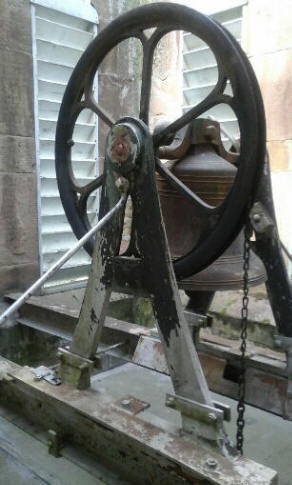

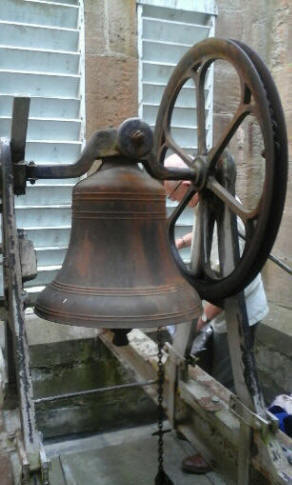
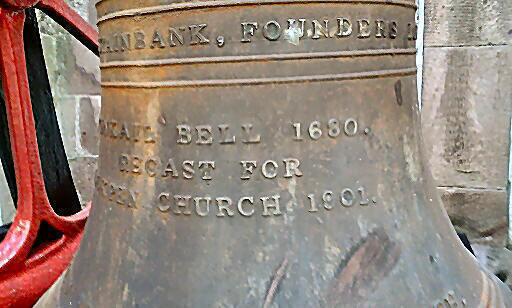
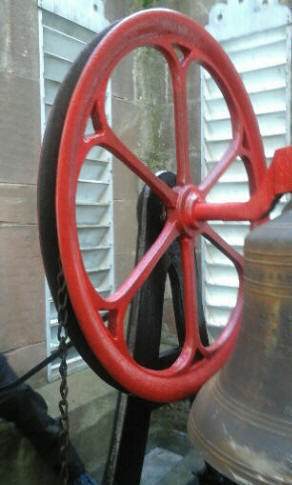


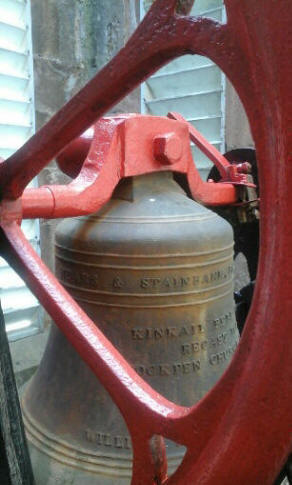 |
